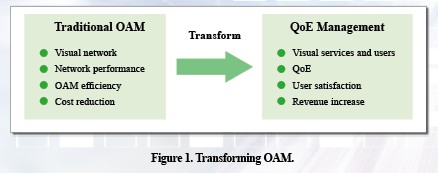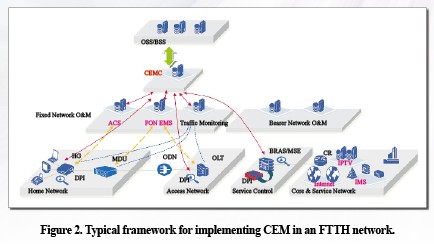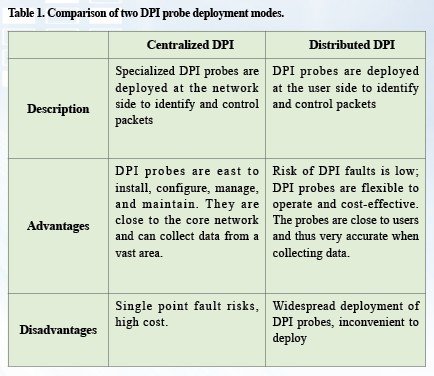Tapping the Value of FTTH Users
 It's a pleasure for me to be here to introduce CSL and the experience that we had with LTE over the past two years. Back in 2010, we were the first company to launch a dual band LTE network in Asia.
It's a pleasure for me to be here to introduce CSL and the experience that we had with LTE over the past two years. Back in 2010, we were the first company to launch a dual band LTE network in Asia.
PON boosts user bandwidth, but how can operators benefit from this? In this article, we discuss the urgency of shifting the focus of network OAM from KPI management to QoE management. We outline a QoE management architecture and how it may be applied in FTTH networks. We also describe how to use ONU DPI to cheaply implement FTTH QoE management and how to tap the value of FTTH users.
FTTH QoE Management Helps Increase Broadband Revenue
Many recent PON rollouts have rapidly expanded the FTTH user base and also the basic capabilities of broadband access networks. This has created a promising future for high-bandwidth services.
Bits of data passing through a broadband pipe have different value. Data belongs to different ISPs and different services, and the money paid by end users, ISPs, and other hidden stakeholders for this data can vary greatly. Value difference presents big opportunities. For example, a bit generated by browsing a webpage might have less value than a bit generated by playing a paid online game. Even the same bits generated from internet browsing may have different value according to the webpages viewed.
Telecom operators create the huge space within which data can realize its value. These operators urgently need to transform their business models and OAM mechanisms as opposed to merely increasing their operational income by increasing bit traffic. They must identify, manage, apply, and expand bit value.
Traditional OAM focuses on equipment, faults, and network. Maintenance is based on user complaint mechanisms, so faults cannot be proactively detected. This kind of management involves equipment management, alarm management, and performance management.
Network OAM and management need to be redirected towards QoE so that each user and service experience can be clearly viewed (Fig. 1)

QoE management helps grow the number of front-end users and services. and also serves as a basic tool for operators to tap the value of different users, services, and ISPs. Operators can also implement forward or backward charging.
CEM and Applications
Customer experience management (CEM) is designed to measure and express the service experience of a specific user or group. CEM uses quantitative indexes to represent user service and network experience and to reflect the gap between what users expect and the actual quality of services and networks.

The customer experience management center (CEMC) uses active and passive probes deployed in the network to collect information about network and service operation. CEMC interacts with ACS, PON EMS, and traffic monitoring systems to obtain information about network and equipment operation, and it also interacts with OSS to acquire user SLA information (Fig. 2). By integrating and drilling down all this information in multiple dimensions, CEMC can analyze and manage FTTH users and services in real-time. Key aspects of CEM are
● customer experience management, which involves QoE management for specific customers.
● SLA management, which involves QoS baseline management.
● QoS management, which allows for visual management of all services.
● service fault location, which involves automatic diagnosis and accumulating troubleshooting experience.
● user behavior analysis.
With these key functions, CEM provides service support for different operator departments.
CEM application for front-end marketing
● VIP user experience management. CEM evaluates VIP user experience, accesses user-related service or network indexes, and provides corresponding service assurance that involves monitoring, guaranteeing, and caring for VIP user experience.
● user experience analysis. By analyzing user service experience, CEM provides reference data for operators to make management decisions and helps them attract and retain users.
CEM application for back-end OAM
● network OAM assurance. CEM monitors specific services in real time, and QoS can be automatically or manually evaluated. CEM details the causes of low-quality service, suggests improvements, and manages the SLA.
● end-to-end network quality evaluation. CEM performs a segment-by-segment analysis of key indexes, including DNS delay, packet loss ratio for an access link, HTTP first-byte delay, and DHCP access success rate. CEM also performs a statistical analysis of user distribution and failure type in each segment and displays analysis indexes in all related dimensions. In this way, CEM helps an operator determine network quality and user distribution.
● fault location. CEM obtains data from data sources and uses them in combination with an expert knowledge base to automatically locate service faults.
CEM application for front-end customer service
● retaining very angry persons (VAP). CEM analyzes user service data and sifts out VAPs. Then, it evaluates VAP user service experience and analyzes and solves problems to reduce complaints. The process involves VAP user identification, VAP user experience monitoring, and VAP user fault analysis.
Tapping the Value of FTTH Users: ONU DPI
CEM analyzes the statistics of a huge amount of network operation data. This data may be network management and traffic data, including data about resources, network and traffic that reflects the status of a rugged communication pipe. The data may also be DPI data, including data about service interaction and service performance that indicates the status of a refined communication pipe.
DPI data is generally obtained by deploying DPI probes in the network. Probes are deployed at the network side (in a centralized way) or at the user side (in a distributed way).
These two methods of deployment have their own advantages and disadvantages (Table 1). The decision to deploy DPI probes at the network or user side should be determined by actual needs.

At the user side, a DPI module can be integrated into a PON home gateway unit (HGU). This can circumvent the need to install a standalone DPI probe at the user side. This method of deployment has the following advantages:
● The DPI probe can accurately locate users, and analyze and control specific user services.
● The DPI probe is a service originator that provides QoS guarantee and filters abnormal traffic at the source.
● The DPI probe allows for fine-grained analysis and control of different user terminals within a home.
● The DPI probe perceives the status of user service as soon as possible and responds to faults in real time.
● DPI probes are deployed in a distributed way and are implemented by software. There is no need to invest in hardware. Requirements can be fulfilled in stages, and short-term results can be obtained.
Differentiating to allow operators to charge specific ISP services
Operators can sign differentiated service agreements with ISPs to guarantee services and charge ISPs for them. FT recently signed a differentiated service charge agreement with Google. This is a good attempt at collaboration between upstream and downstream enterprises in the value chain and will improve user QoE and ISP QoS.
Guaranteeing QoS to develop self-run services
CEM provides QoS guarantee for self-run services. CEM analyzes the content of IP packets, identifies self-run services (by finding and matching keywords), designates key services, and provides a QoS guarantee. This helps establish high-quality self-run services.
Guiding marketing and boosting operating income
CEM uses traffic statistics to identify the distribution of high-value users. An operator can proactively target their marketing activities to people who use services heavily and need high bandwidth. They can also increase ARPU by quickly offering free trial high-speed services and then later signing a contract with the user.
Monitoring network quality at the user side to improve QoE
More and more value-added services are connected to the network through HGUs. CEM uses ONU DPI to monitor network quality and can determine QoS at the user side. This first-hand QoE data helps an operator optimize their network and improve user QoE.
Much work is being done on CEM for PON. As operators quickly transform their businesses, CEM will be widely used as a basic management tool.